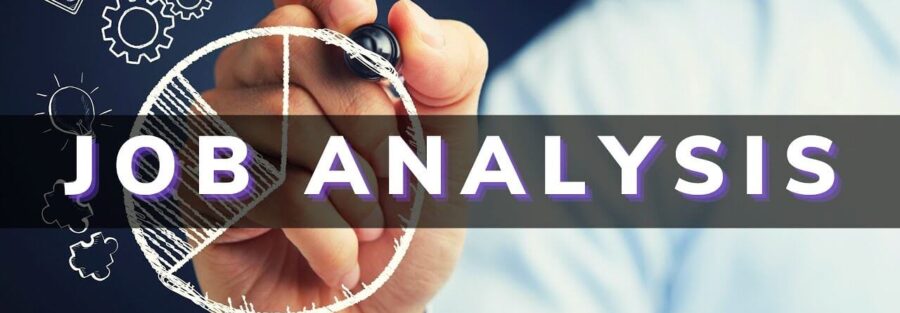Job analysis
Job Analysis
It is also called
(Human Resource Audit) Human resources audit
(Job Study)
(Occupational Analysis) Occupational analysis
Organizations rely on job analysis to make appropriate decisions regarding employee management and recruitment. The outputs of job analysis are considered the primary source for determining performance standards, as well as providing information related to employees and identifying and developing training needs. In this article, we will learn about the concept of job analysis, its uses, and its forms.
Concept of job analysis:
It is the process of collecting and analyzing information about an existing job in the labor market to determine the knowledge, skills, and abilities needed to perform the job effectively. The following areas must be covered in job analysis:
- Job duties and responsibilities: A list of tasks and responsibilities necessary to perform the job.
- Knowledge and skills: The knowledge, skills, and abilities required to perform the job, including educational qualifications.
- Conditions for performing the job: The physical, social, and organizational context in which a job is performed, including the work environment, tools and equipment used, and the social and cultural norms of the workplace.
- Performance Standards: The expected level of performance for the job, including any quantitative or qualitative criteria used to evaluate performance.
- Required behaviors: Specific behaviors required to perform a job successfully, such as communication skills, teamwork, and problem-solving abilities.
- Training requirements: The training required to perform the job effectively, including any on-the-job training or external training programs.
- Supervision: The level of supervision required for the job, including the degree of independence and decision-making authority granted to the job holder.
- Salary and benefits: Salary and benefits associated with the job, including any bonus or commission structures and benefits packages.
- Career development opportunities: Career development opportunities associated with the job, including the possibility of advancement or lateral movement within the organization.
- Safety and health considerations: Any safety and health considerations associated with the job, including physical demands, exposure to hazardous materials, or any other potential risks to the job holder's health or safety.
When to use job analysis:
- Recruitment and selection: Job analysis can be used to determine the skills, knowledge, and abilities needed for a particular job, which can help design effective job advertisements and select the best candidates for the job.
- Performance evaluation: Job analysis can be used to establish performance standards, which can help evaluate employee performance and identify areas for improvement.
- training and development: Job analysis can be used to determine the specific knowledge, skills, and abilities required for a job, which can help design effective training and development programs.
- Compensation and benefits: Job analysis can be used to determine the relative value of different jobs within an organization, which can help create fair and equitable compensation and benefits packages.
- Job design and redesign: Job analysis can be used to identify opportunities to improve job design, such as simplifying job tasks or introducing new technologies, to make jobs more efficient and effective.
In general, job analysis is a useful tool for understanding job requirements and how they fit into the organization, and can be used in a wide range of HR activities.
How to collect data for job analysis:
Job analysis can take many forms depending on the organization and the specific needs of the job. Some common forms of job analysis include:
- Job Analysis Questionnaires: These are standardized questionnaires completed by job holders, supervisors, or subject matter experts to collect information about job duties, responsibilities, and required skills.
- Interviews: Individual interviews with job holders, supervisors, or subject matter experts can be used to gather information about job tasks, responsibilities, and required knowledge and skills.
- Note: Direct observation of job holders can be used to gather information about job tasks, physical demands, and environmental conditions.
- Focus groups: Focus groups can be used to gather information from groups of job holders or subject matter experts about job duties, responsibilities, and required skills.
- Critical accident technologyThis method includes collecting information about specific incidents or situations that show effective or ineffective job performance.
- Job performance data: Analysis of actual job performance data, such as productivity or quality measures, can help determine the key duties, responsibilities and skills required for the job.
- Work diary: Job holders can keep a record of their activities over a period of time, which can provide detailed information about the duties, responsibilities and skills required for the job.
The specific model used for job analysis will depend on the organization's needs and resources, and may include a range of methods to gather comprehensive and accurate information about the job.
Job analysis outputs:
The outputs of job analysis can vary depending on the purpose and scope of the analysis. However, some common deliverables of job analysis include:
Job Description: A written summary of the major duties and responsibilities of the job, along with the knowledge, skills, and abilities required.
Job Specifications: A written summary of the specific qualifications, education, experience, and other characteristics required for successful job performance.
Performance Standards: Written descriptions of the expected level of performance for the job, including any quantitative or qualitative criteria used to evaluate performance.
Training materials: A detailed description of the knowledge, skills and abilities required for the job, which can be used to develop training materials and programmes.
Selection tests and procedures: Job analysis can provide the information necessary to design tests and selection procedures that accurately measure the knowledge, skills, and abilities required for the job.
Job redesign recommendations: Job analysis can identify opportunities to improve job design, such as simplifying job tasks or introducing new technologies, to make jobs more efficient and effective.
Overall, the outputs of job analysis provide valuable information that can be used to improve organizational performance, enhance employee satisfaction and engagement, and support effective human resource management.
We hope that this article has given a clear introduction about the concept of job analysis, its uses, and its effective importance for human resources and the organization in general.




